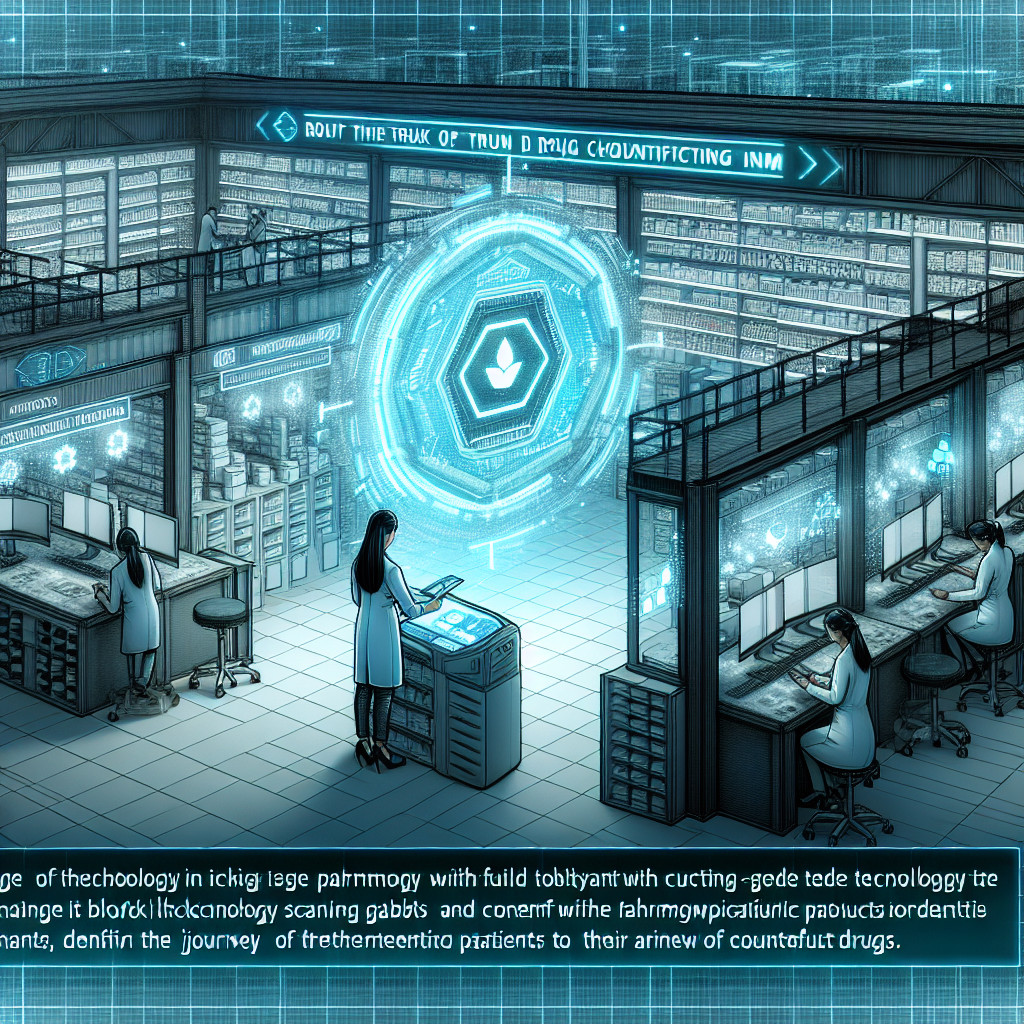
Technology as a way to reduce drug counterfeiting
- The role of technology in combating drug counterfeiting
- RFID technology in tracking and tracing pharmaceutical products
- Machine learning algorithms for identifying counterfeit drugs
- Cloud computing for secure data storage and sharing in the pharmaceutical industry
- Quantum encryption technology for securing drug supply chains
- Machine learning algorithms for analyzing patterns of counterfeit drug distribution
- RFID technology in tracking and tracing pharmaceutical products
- Artificial intelligence in detecting counterfeit drugs
The role of technology in combating drug counterfeiting
One of the key technologies used in the fight against drug counterfeiting is serialization. Serialization involves assigning a unique identifier to each individual unit of a drug, allowing it to be tracked throughout the supply chain. This enables authorities to verify the authenticity of a product and identify any potential counterfeit items.
Another important technology in the battle against counterfeit drugs is blockchain. Blockchain is a decentralized and secure digital ledger that records transactions in a tamper-proof and transparent manner. By utilizing blockchain technology, pharmaceutical companies can create an immutable record of their products’ journey from manufacturing to distribution, ensuring that counterfeit drugs are easily identified and removed from circulation.
Furthermore, advancements in anti-counterfeiting technologies such as holograms, RFID tags, and tamper-evident packaging have also played a significant role in preventing the proliferation of fake drugs. These technologies provide visible and covert security features that make it difficult for counterfeiters to replicate or tamper with legitimate products.
In addition to these technologies, regulatory bodies and law enforcement agencies are increasingly leveraging data analytics and artificial intelligence to analyze large volumes of data and identify patterns indicative of counterfeit drug activity. By using these advanced technologies, authorities can more effectively target and dismantle criminal networks involved in drug counterfeiting.
In conclusion, technology plays a vital role in combating drug counterfeiting by enhancing supply chain transparency, improving product authentication, and enabling swift detection and response to counterfeit activities. By leveraging a combination of serialization, blockchain, anti-counterfeiting technologies, and data analytics, stakeholders can work together to safeguard public health and ensure the integrity of the pharmaceutical industry.
- drug counterfeiting
- technology
- serialization
- blockchain
- anti-counterfeiting technologies
- data analytics
- artificial intelligence
- combating drug counterfeiting
- pharmaceutical industry
- supply chain transparency
- product authentication
- counterfeit activities
#drugcounterfeiting, #technology, #serialization, #blockchain, #anticounterfeitingtechnologies, #dataanalytics, #artificialintelligence
RFID technology in tracking and tracing pharmaceutical products
Furthermore, RFID technology can also be used to authenticate pharmaceutical products, ensuring that they are not counterfeit or tampered with. This can help to protect consumers from potentially harmful products and maintain the integrity of the pharmaceutical supply chain.
In addition to tracking and tracing pharmaceutical products, RFID technology can also be used to improve inventory management and reduce the risk of product expiration. By monitoring the movement of products in real-time, companies can better manage their inventory levels and ensure that products are used before they expire.
Overall, RFID technology has the potential to revolutionize the pharmaceutical industry by providing greater visibility and control over the supply chain. By implementing RFID technology, companies can improve the safety, security, and efficiency of their operations, ultimately benefiting both consumers and the industry as a whole.
Key benefits of RFID technology in tracking and tracing pharmaceutical products:
- Real-time monitoring of product movement
- Authentication of pharmaceutical products
- Improved inventory management
- Reduced risk of product expiration
Keywords:
RFID technology, tracking, tracing, pharmaceutical products, supply chain, inventory management, authentication, counterfeit, tampering
Long-tail phrases:
RFID technology in pharmaceutical supply chain, real-time monitoring of pharmaceutical products, RFID authentication in pharmaceutical industry
#RFID #pharmaceutical #tracking #tracing #supplychain #inventorymanagement #authentication #counterfeit #tampering
Machine learning algorithms for identifying counterfeit drugs
There are several different types of machine learning algorithms that can be used to identify counterfeit drugs. One common approach is to use supervised learning algorithms, which are trained on a dataset of known counterfeit and authentic drugs. These algorithms can then be used to classify new products as either counterfeit or authentic based on their features.
Another approach is to use unsupervised learning algorithms, which do not require a labeled dataset. Instead, these algorithms can identify patterns and anomalies in the data that may indicate a counterfeit product. For example, clustering algorithms can group similar products together, making it easier to identify outliers that may be counterfeit.
In addition to image and text data, machine learning algorithms can also analyze other types of data to identify counterfeit drugs. For example, chemical analysis data can be used to detect counterfeit drugs that may contain harmful substances. By combining multiple types of data, machine learning algorithms can provide a more comprehensive approach to identifying counterfeit drugs.
Overall, machine learning algorithms have shown great promise in the fight against counterfeit drugs. By automating the detection process and analyzing large amounts of data, these algorithms can help inspectors and pharmaceutical companies quickly identify and remove counterfeit products from the market.
#MachineLearning #CounterfeitDrugs #Pharmaceuticals #PublicHealth
frazy kluczowe:
– Machine learning algorithms for detecting counterfeit drugs
– Using AI to identify counterfeit pharmaceuticals
– Automated detection of counterfeit drugs using ML algorithms
– Preventing public health risks with machine learning algorithms
– Combating counterfeit drugs with artificial intelligence
Cloud computing for secure data storage and sharing in the pharmaceutical industry
📊 Data storage and sharing in the pharmaceutical industry can be a complex and resource-intensive process. Cloud computing offers a scalable solution that allows companies to easily expand their storage capacity as needed, without the need for costly hardware upgrades or maintenance. This flexibility enables pharmaceutical companies to adapt to changing data storage requirements and scale their operations efficiently.
💰 Cost-effectiveness is another key advantage of cloud computing for pharmaceutical companies. By moving data storage and sharing to the cloud, companies can reduce their reliance on expensive on-premises infrastructure and maintenance costs. Cloud computing services are typically offered on a pay-as-you-go basis, allowing companies to only pay for the storage and resources they actually use. This can result in significant cost savings for pharmaceutical companies, especially those with limited IT budgets.
🌐 Accessibility is essential for pharmaceutical companies that need to access and share data across multiple locations and devices. Cloud computing enables secure access to data from anywhere with an internet connection, making it easier for employees to collaborate on projects, access critical information, and make informed decisions in real-time. This level of accessibility can improve productivity and streamline workflows within pharmaceutical companies.
Overall, cloud computing offers a secure, scalable, cost-effective, and accessible solution for data storage and sharing in the pharmaceutical industry. By leveraging cloud-based services, companies can enhance their data management practices, improve security measures, and streamline operations to drive innovation and growth in the industry.
#CloudComputing #DataStorage #PharmaceuticalIndustry #SecureDataSharing
słowa kluczowe: chmura obliczeniowa, przechowywanie danych, udostępnianie danych, przemysł farmaceutyczny, bezpieczeństwo danych
frazy kluczowe: korzyści chmury obliczeniowej dla przemysłu farmaceutycznego, przechowywanie danych w chmurze dla bezpieczeństwa, udostępnianie danych w chmurze dla farmacji, najlepsze praktyki przechowywania danych w przemyśle farmaceutycznym.
Quantum encryption technology for securing drug supply chains
What is quantum encryption technology?
Quantum encryption technology is a cutting-edge method of securing data using the principles of quantum mechanics. Unlike traditional encryption methods, which rely on mathematical algorithms, quantum encryption uses the unique properties of quantum particles to encode and decode information. This makes it virtually impossible for hackers to intercept or tamper with encrypted data.
How can quantum encryption technology be applied to drug supply chains?
One of the key applications of quantum encryption technology in drug supply chains is in securing the transmission of sensitive information between different stakeholders, such as manufacturers, distributors, and pharmacies. By using quantum encryption to protect data such as drug authenticity, batch numbers, and expiration dates, companies can ensure that only authorized parties have access to this information.
Furthermore, quantum encryption technology can also be used to track the movement of drugs throughout the supply chain. By encrypting data on each individual drug package using quantum encryption, companies can create a secure and tamper-proof record of each drug’s journey from the manufacturer to the end consumer. This not only helps to prevent counterfeiting and theft but also enables companies to quickly identify and address any issues that may arise during transit.
Benefits of quantum encryption technology for drug supply chains
– Enhanced security: Quantum encryption technology provides a higher level of security than traditional encryption methods, making it extremely difficult for hackers to breach the system.
– Real-time tracking: By encrypting data on individual drug packages, companies can track the movement of drugs in real-time, allowing for greater transparency and accountability.
– Improved trust: With quantum encryption technology in place, consumers can have greater confidence in the authenticity and safety of the drugs they are purchasing.
Challenges and future prospects
While quantum encryption technology shows great promise for securing drug supply chains, there are still some challenges that need to be addressed. These include the high cost of implementing quantum encryption systems, as well as the need for standardized protocols and regulations to ensure interoperability between different stakeholders.
However, with ongoing research and development in the field of quantum encryption technology, it is likely that these challenges will be overcome in the near future. As the technology becomes more widespread and affordable, it has the potential to revolutionize the way drugs are secured and tracked throughout the supply chain.
Overall, quantum encryption technology holds great promise for enhancing the security and integrity of drug supply chains. By leveraging the unique properties of quantum mechanics, companies can ensure that their products are protected from counterfeiters, thieves, and other malicious actors.
#QuantumEncryption #DrugSupplyChains #PharmaceuticalIndustry #DataSecurity #CounterfeitDrugs #SupplyChainSecurity
frazy kluczowe:
– Quantum encryption technology for pharmaceutical supply chains
– Benefits of quantum encryption for drug tracking
– Challenges of implementing quantum encryption in drug supply chains
Machine learning algorithms for analyzing patterns of counterfeit drug distribution
One of the key advantages of using machine learning algorithms for this task is their ability to process large amounts of data quickly and efficiently. By analyzing sales records, shipping routes, and other relevant information, these algorithms can detect patterns that may indicate the presence of counterfeit drugs in the supply chain.
Some of the most commonly used include:
– 🤖 Support Vector Machines (SVM): SVMs are a type of supervised learning algorithm that can be used to classify data into different categories. In the context of counterfeit drug distribution, SVMs can be trained to identify patterns that are characteristic of fake medications.
– 🧠 Neural Networks: Neural networks are a type of deep learning algorithm that can be used to detect complex patterns in data. By training a neural network on a dataset of known counterfeit drugs, researchers can develop a model that can identify similar patterns in new data.
– 📊 Random Forest: Random Forest is an ensemble learning algorithm that combines the predictions of multiple decision trees to improve accuracy. In the context of counterfeit drug distribution, Random Forest can be used to identify key features that are associated with fake medications.
By using these machine learning algorithms, researchers and law enforcement agencies can gain valuable insights into the distribution patterns of counterfeit drugs and take proactive measures to prevent their spread. By identifying key indicators of counterfeit drug distribution, such as unusual shipping routes or suspicious sales patterns, authorities can target their efforts more effectively and reduce the prevalence of fake medications in the market.
In conclusion, machine learning algorithms offer a powerful tool for analyzing patterns of counterfeit drug distribution and identifying potential sources of fake medications. By leveraging the capabilities of these algorithms, researchers and law enforcement agencies can work together to combat this growing threat to public health.
#counterfeit #drugdistribution #machinelearning #algorithm #pharmaceuticalindustry
frazy kluczowe:
– Machine learning algorithms for counterfeit drug distribution analysis
– Patterns detection in counterfeit drug distribution using machine learning
– Using SVM and Neural Networks for counterfeit drug distribution analysis
RFID technology in tracking and tracing pharmaceutical products
RFID technology also enables quick and accurate inventory management, reducing the risk of stockouts and overstocking. By automatically updating inventory levels in real-time, RFID systems help to streamline the supply chain and improve overall efficiency. This not only saves time and money but also ensures that patients have access to the medications they need when they need them.
Furthermore, RFID technology can be used to monitor the temperature and humidity of pharmaceutical products during transportation and storage. This is crucial for ensuring the quality and efficacy of medications, especially those that are sensitive to environmental conditions. By using RFID sensors, healthcare providers can quickly identify and address any issues that may arise, preventing product spoilage and ensuring patient safety.
In addition to tracking and tracing pharmaceutical products, RFID technology can also be used to authenticate products and prevent counterfeit medications from entering the supply chain. By verifying the authenticity of each product at every stage of the supply chain, RFID systems help to protect patients from potentially harmful counterfeit drugs.
In conclusion, RFID technology plays a crucial role in tracking and tracing pharmaceutical products, ensuring their authenticity, safety, and efficacy. By providing real-time visibility, improving inventory management, monitoring environmental conditions, and preventing counterfeiting, RFID systems help to safeguard patient health and well-being.
- RFID technology
- pharmaceutical products
- tracking and tracing
- supply chain
- patient safety
- RFID technology in pharmaceutical industry
- Real-time visibility in supply chain
- Inventory management with RFID
- Temperature monitoring of medications
- Authentication and anti-counterfeiting measures
#RFID #pharmaceuticals #tracking #supplychain #patientsafety
Artificial intelligence in detecting counterfeit drugs
How AI is used in detecting counterfeit drugs:
- Image recognition: AI algorithms can analyze images of drugs to detect any inconsistencies or irregularities in packaging or labeling.
- Chemical analysis: AI can analyze the chemical composition of drugs to determine if they are authentic or counterfeit.
- Data mining: AI can sift through vast amounts of data to identify patterns that may indicate counterfeit drugs.
- Blockchain technology: AI can be used to track the supply chain of drugs, ensuring that they are not tampered with or counterfeit.
Benefits of using AI in detecting counterfeit drugs:
- Increased accuracy: AI can detect counterfeit drugs with a higher level of accuracy than traditional methods.
- Cost-effective: Using AI can save time and resources compared to manual inspection methods.
- Real-time detection: AI can quickly identify counterfeit drugs as they enter the market, preventing harm to consumers.
Overall, artificial intelligence is proving to be a valuable tool in the fight against counterfeit drugs. By leveraging AI technology, we can better protect consumers and ensure the safety and efficacy of medications. Hashtags: #AI #counterfeitdrugs #pharmaceuticals
Keywords: artificial intelligence, counterfeit drugs, detection, medication, safety
Long-tail phrases: using AI to detect counterfeit drugs, benefits of AI in pharmaceutical industry, AI technology in drug authentication
- Laser cleaning for removing contaminants from fabric surfaces - 25 May 2024
- Who is who in a software house - 25 May 2024
- Technology as a way to reduce drug counterfeiting - 25 March 2024




